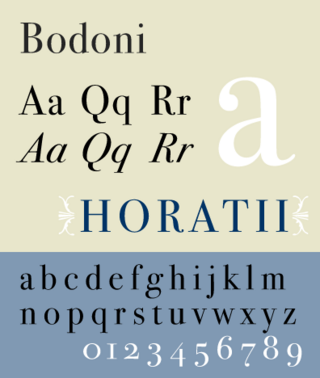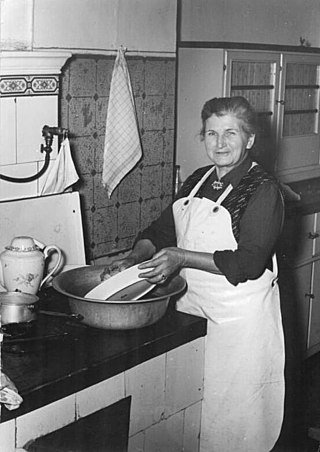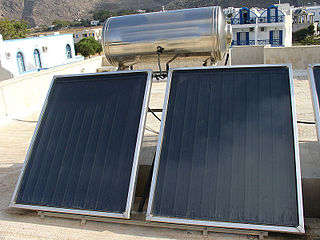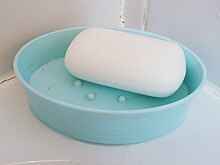
Soap is a salt of a fatty acid used for cleaning and lubricating products as well as other applications. In a domestic setting, soaps, specifically "toilet soaps", are surfactants usually used for washing, bathing, and other types of housekeeping. In industrial settings, soaps are used as thickeners, components of some lubricants, emulsifiers, and catalysts.

A dishwasher is a machine that is used to clean dishware, cookware, and cutlery automatically. Unlike manual dishwashing, which relies on physical scrubbing to remove soiling, the mechanical dishwasher cleans by spraying hot water, typically between 45 and 75 °C, at the dishes, with lower temperatures of water used for delicate items.

A sink is a bowl-shaped plumbing fixture for washing hands, dishwashing, and other purposes. Sinks have a tap (faucet) that supplies hot and cold water and may include a spray feature to be used for faster rinsing. They also include a drain to remove used water; this drain may itself include a strainer and/or shut-off device and an overflow-prevention device. Sinks may also have an integrated soap dispenser. Many sinks, especially in kitchens, are installed adjacent to or inside a counter.

Bodoni is the name given to the serif typefaces first designed by Giambattista Bodoni (1740–1813) in the late eighteenth century and frequently revived since. Bodoni's typefaces are classified as Didone or modern. Bodoni followed the ideas of John Baskerville, as found in the printing type Baskerville—increased stroke contrast reflecting developing printing technology and a more vertical axis—but he took them to a more extreme conclusion. Bodoni had a long career and his designs changed and varied, ending with a typeface of a slightly condensed underlying structure with flat, unbracketed serifs, extreme contrast between thick and thin strokes, and an overall geometric construction.

A bathroom is a room in which people wash their bodies or parts of their bodies. It can contain one or more of the following plumbing fixtures: a shower, a bathtub, a bidet, and a sink. The inclusion of a toilet is common. There are also specific toilet rooms, only containing a toilet, which in North American English tend to be called "bathrooms", "powder rooms" or "washrooms", as euphemisms to conceal their actual purpose, while they in British and Irish English are known as just "toilets" or possibly "cloakrooms" - but also as "lavatories" when they are public.

A shower is a place in which a person bathes under a spray of typically warm or hot water. Indoors, there is a drain in the floor. Most showers have temperature, spray pressure and adjustable showerhead nozzle. The simplest showers have a swivelling nozzle aiming down on the user, while more complex showers have a showerhead connected to a hose that has a mounting bracket. This allows the showerer to hold the showerhead by hand to spray the water onto different parts of their body. A shower can be installed in a small shower stall or bathtub with a plastic shower curtain or door. Showering is common due to the efficiency of using it compared with a bathtub. Its use in hygiene is, therefore, common practice.

Dishwashing, washing the dishes, doing the dishes, or washing up in Great Britain, is the process of cleaning cooking utensils, dishes, cutlery and other items to prevent foodborne illness. This is either achieved by hand in a sink using dishwashing detergent or by using a dishwasher and may take place in a kitchen, utility room, scullery or elsewhere.

A solar thermal collector collects heat by absorbing sunlight. The term "solar collector" commonly refers to a device for solar hot water heating, but may refer to large power generating installations such as solar parabolic troughs and solar towers or non-water heating devices such as solar cookers or solar air heaters.
Ivory is an American flagship personal care brand created by the Procter & Gamble Company (P&G), including varieties of white and mildly scented bar soap that became famous for its claim of purity and for floating on water. Over the years, the brand has been extended to other varieties and products.

Josephine Cochran was an American inventor who invented the first successful hand-powered dishwasher, which she designed and then constructed with the assistance of mechanic George Butters, who became one of her first employees.

A washstand or basin stand is a piece of furniture consisting of a small table or cabinet, usually supported on three or four legs, and most commonly made of mahogany, walnut, or rosewood, and made for holding a wash basin and water pitcher. The smaller varieties were used for rose-water ablutions, or for hair-powdering. The larger ones, which possessed receptacles for soap dishes, were the predecessors of the modern bathroom wash basin, or sink. Both varieties, often of very elegant form, were in extensive use throughout a large part of the 18th century and early-19th century, eventually disappearing with the advent of modern indoor plumbing.

Dishwashing liquid, or dishwashing soap, dish detergent, and dish soap is a detergent assisting in dishwashing. Dishwashing detergents for dishwashers come in various forms like cartridges, gels, liquids, pacs, powder, and tablets. It is usually a highly-foamy mixture of surfactants with low skin irritation that consumers primarily use for washing glasses, plates, cutleries, and cooking utensils. In addition to its primary use, dishwashing liquid also has various informal applications, like creating bubbles, clothes washing, and cleaning birds from oil spills.

Jefferson Randolph "Soapy" Smith II was an American con artist and gangster in the American frontier, and ultimately the Klondike.

Massimo Vignelli was an Italian designer who worked in a number of areas including packaging, houseware, furniture, public signage, and showroom design. He was the co-founder of Vignelli Associates, with his wife, Lella. His motto was, "If you can design one thing, you can design everything," which the broad range of his work reflects.
Bathtub refinishing is a process of restoring the surface of a bathtub to improve its appearance and durability. It involves applying a new coating or finish on the existing bathtub surface, which can be made of materials such as porcelain, fiberglass, acrylic, or enamel.

A dish drying cabinet is a piece of kitchen shelving placed above the sink, with an open bottom and shelves made of steel wire or dowels to allow washed dishes set within to drip into the sink and air dry.

Shaving soap is a hard soap that is used to produce lather with a shaving brush. The lather it produces is used to coat the face during shaving, softening the hair in preparation for shaving.
Palmolive is an American multinational brand of a line of products produced by Colgate-Palmolive. The Palmolive brand grew from one product, Palmolive bar soap. Made of coconut, palm and olive oils, Palmolive bar soap was introduced in 1898. Originally, the bar soap floated like Procter & Gamble's Ivory bar soap. By the turn of the 20th century, Palmolive bar soap was the world's best-selling soap.

Union Street Café was a restaurant, owned by chef Gordon Ramsay, in Southwark, London. It was the first of Ramsay's restaurants to be opened without the involvement of Chris Hutchinson, and at one point was backed by footballer David Beckham. The Café served Mediterranean cuisine, with mostly Italian dishes. The head chef, Davide Degiovanni, designed the menu, which was changed daily. Before the Café was opened, it received more than 10,000 booking requests, with seating filled to the end of the year. Food critics' reviews have been mixed, with differing opinions of the veal saltimbocca but agreement in dislike of a dish of octopus, borlotti bean, and 'nduja sausage. Union Street Café was replaced by Gordon Ramsay Restaurants in December 2020 with their third Street Pizza Location, joined at that address in May 2021 by their second Bread Street Kitchen & Bar location for London.

A washboard is a tool designed for hand washing clothing. With mechanized cleaning of clothing becoming more common by the end of the 20th century, the washboard has become better known for its secondary use as a musical instrument.



















